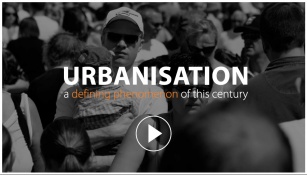How to design a smart city
Over half the planet's population now lives in cities. This figure is predicted to rise to more than 70% by the second half of the century.
Cities are becoming our economic powerhouses; competing to attract global businesses, skilled employees and eager consumers. The basis of this competition is broad and includes: access to education and jobs, personal safety and security, effective healthcare, efficient transport, an attractive physical environment and vibrant communities.
However, whilst densely populated cities should be more sustainable than less concentrated rural settlements, they actually account for more than 75% of the consumption of non-renewable resources, and create around 75% of global pollution. With climate change threatening many cities through rising sea levels, increasingly volatile weather patterns and diminishing resources, the governments of both developed and developing countries face the demand not only for improved social conditions and better economic prospects, but also, greater resilience and more environmentally-sound city forms.
If we collaborate, and view these challenges as opportunities, smart city solutions may offer us a way forward. Smart cities not only optimise the use of technology in the design and operation of infrastructure and buildings, they also consider governance and growth, urban development and infrastructure, the environment and natural resources, society and community.
Creating smart cities is a complex, long-term process, and its success depends on a sustained commitment to a clear course of action. Smart cities require a genuinely integrated, multi-disciplinary approach. Design teams must operate across the complete project lifecycle, from assessing the physical opportunities and constraints and considering the viability of options, to working with planners and developers to design and build the best solutions.
Featured articles and news
One of the most impressive Victorian architects. Book review.
RTPI leader to become new CIOB Chief Executive Officer
Dr Victoria Hills MRTPI, FICE to take over after Caroline Gumble’s departure.
Social and affordable housing, a long term plan for delivery
The “Delivering a Decade of Renewal for Social and Affordable Housing” strategy sets out future path.
A change to adoptive architecture
Effects of global weather warming on architectural detailing, material choice and human interaction.
The proposed publicly owned and backed subsidiary of Homes England, to facilitate new homes.
How big is the problem and what can we do to mitigate the effects?
Overheating guidance and tools for building designers
A number of cool guides to help with the heat.
The UK's Modern Industrial Strategy: A 10 year plan
Previous consultation criticism, current key elements and general support with some persisting reservations.
Building Safety Regulator reforms
New roles, new staff and a new fast track service pave the way for a single construction regulator.
Architectural Technologist CPDs and Communications
CIAT CPD… and how you can do it!
Cooling centres and cool spaces
Managing extreme heat in cities by directing the public to places for heat stress relief and water sources.
Winter gardens: A brief history and warm variations
Extending the season with glass in different forms and terms.
Restoring Great Yarmouth's Winter Gardens
Transforming one of the least sustainable constructions imaginable.
Construction Skills Mission Board launch sector drive
Newly formed government and industry collaboration set strategy for recruiting an additional 100,000 construction workers a year.
New Architects Code comes into effect in September 2025
ARB Architects Code of Conduct and Practice available with ongoing consultation regarding guidance.
Welsh Skills Body (Medr) launches ambitious plan
The new skills body brings together funding and regulation of tertiary education and research for the devolved nation.
Paul Gandy FCIOB announced as next CIOB President
Former Tilbury Douglas CEO takes helm.























